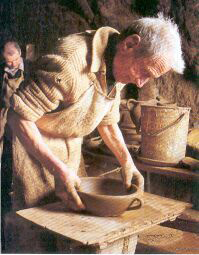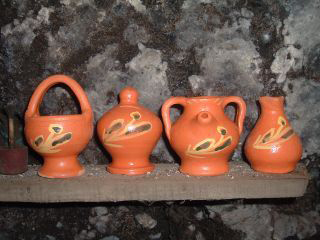Sometimes, when I have some leisure time – not very often I’m afraid – I like to explore the neighborhood of Viterbo where I have been living for the past 5 years. I must admit that I still need to learn a lot about this rich area known as Etruria.  It is an untouched and charming area half way between Rome and Tuscany, where Etruscan and Roman heritage continue to live.
It is an untouched and charming area half way between Rome and Tuscany, where Etruscan and Roman heritage continue to live.
Well, as I said, I was driving on the Via Cassia when I decided to stop in Vetralla. My friend Mary Jane had told me about an old potter working there and I decided to pay him a visit. I’ll never thank her enough.
I had to stop a couple of times and ask for directions. I could not believe my eyes: the place I was looking for is a dark grotto on the hillside where the only light is from the doorway and a bare light bulb. Felice, the last “pilaro” (pot maker) in Vetralla, works there, just as his ancestors used to do.
His only tools are the wooden potter’s wheel, a piece of metal string to “cut” the finished piece from the wheel and his hands. He forms the 8-10 types of traditional pots, jugs and plates just as his ancestors did using clay excavated from the nearby hills. The family’s “signature” – a green and gold olive sprig – decorates each piece Felice creates.
Felice Ricci is better known by his family’s nickname – Checco Lallo. He is the last of a dynasty of 5 families of potters who lived and worked in Vetralla, a village whose production of pignatte (two handled pots) and cannate (pitchers) was highly reputed in the past.
To purchase a piece by this “last potter” one must be in Vetralla and visit the grotto when the forno (kiln) is being emptied.  This happens only 2 -3 times a year for it takes him that long to mold the pieces and fill the giant oven or “forno” in the back of the grotto. The oven is fueled with olive and oak wood and burns continuously for three days and three nights at a temperature of about 1000° C. After a 3 day cooling period, he unbricks the kiln and starts removing pots, pitchers, jugs and plates. Sometimes there are surprises since everything is done approximately. What “Checco Lallo” considers a “mistake” is often a magnificent raku-style pot.
This happens only 2 -3 times a year for it takes him that long to mold the pieces and fill the giant oven or “forno” in the back of the grotto. The oven is fueled with olive and oak wood and burns continuously for three days and three nights at a temperature of about 1000° C. After a 3 day cooling period, he unbricks the kiln and starts removing pots, pitchers, jugs and plates. Sometimes there are surprises since everything is done approximately. What “Checco Lallo” considers a “mistake” is often a magnificent raku-style pot.
I guess the memory of the beautiful pottery from Vetralla will soon be lost, for Felice’s nephew Francesco (who can be seen in the background) has preferred to work as a postman.
For sure it will last in my memories, thanks to Mary Jane, whose friendship is as precious to me as her suggestions of travel itineraries in Etruria are. She captures the magic of it with her website Elegant Etruria and her books – the only ones in English- thus very important for residents and travellers who wish to know more about this beautiful area.

What a wonderful article. Thank you for sharing the experience. To be able to travel back in time, without leaving the here and now, to visit a true craftsman as he performed the ancient magic of transforming simple clay into art was delightful to read. I could almost feel the heat of the kiln and smell the aroma of the burnt wood as it filled the grotto.
Walter